The ancient sulfur baths of St.-Martin-les-Eaux
Historical and natural site
20 min
Information
Description
The hills north of Manosque and therefore in the far east of the Luberon offer great geological diversity with regard to limestone deposits. Coal, sulfur, gypsum, lime and clays were extracted here. Salt is still mined today. The water, which can easily penetrate the limestone faults, rises loaded with different minerals. Ferruginous, salty and sulphurous springs are found in the region.
No reproduction is permitted without the written consent of the author. (id7320)
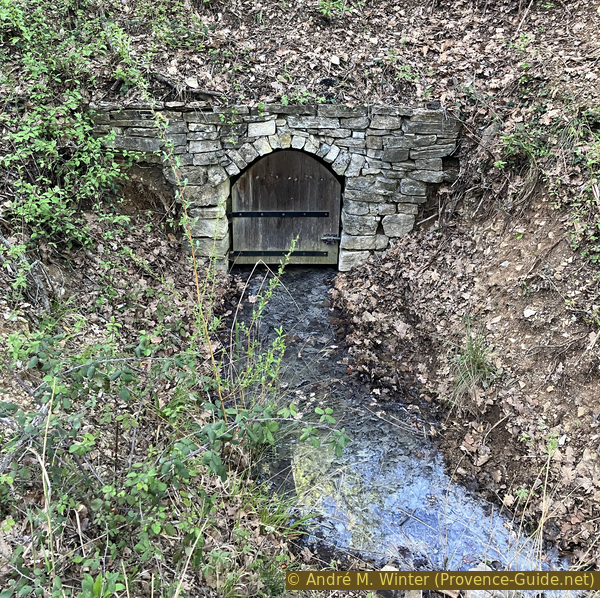
Sulfurous source Huguette in St. Martin les Eaux
Access by public transport
It is not possible to get to the site by public transport. Saint-Maime can be reached by bus, see Zou! (only french), and there are taxi services. Drive from Saint-Maime: 15 minutes.
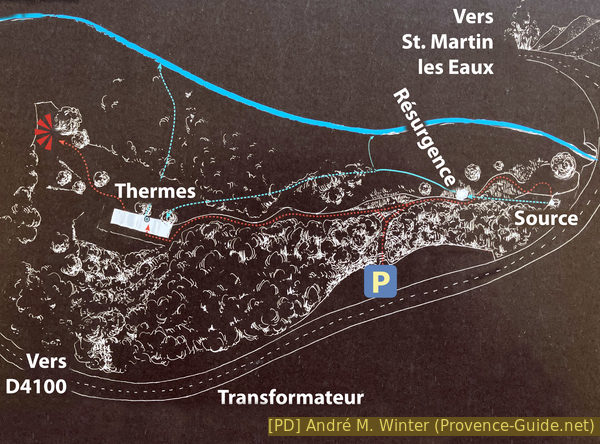
Plan of the ancient thermal baths of St. Martin les Eaux
Access by car
We are in the Manosque region and near the Durance Valley. Except when coming from Lubéron and Vaucluse, you arrive on the A51 motorway at the Manosque exit. Do not cross this city with its eternal traffic jams. Proceed anyway towards Manosque and turn at the roundabout before the EDF canal towards Volx and reach this village. Cross it and head towards Dauphin at the exit and also at the following intersections. After also turning towards the Zone Artisanale of Saint Maime, we cross the bridge on the left to arrive at Dauphin. Cross the village and head towards the Col du Mort d'Imbert at the exit. Just after the bridge, turn right and an old sign indicates a chapel in Provençal: Nosto-Damo d'Ubajo. Continue this small road and pass the village St.-Martin-les-Eaux. Less than a kilometre later and after a bend to the riight, you find a gravel parking lot on the right.
From Vaucluse and Luberon go through Apt and Cereste towards Forcalquier. Five minutes after the intersection at Les Granons, turn right towards St.-Martin-les-Eaux. We pass a crossroads where you have to keep very hard on the left.
No reproduction is permitted without the written consent of the author. (id7316)
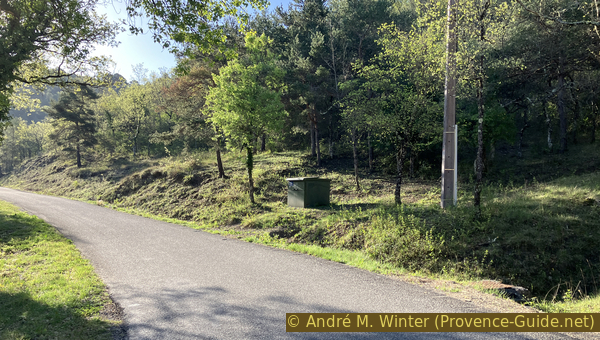
Transformer on the road
Parking site
After the next bend there is a transformer on the right of the road. Shortly after, there follows a gravel parking lot on the left.
No reproduction is permitted without the written consent of the author. (id7317)
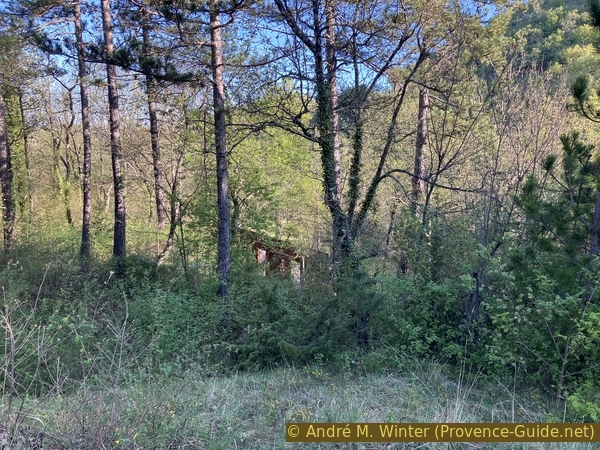
The ancient thermal baths seen from the road
Short trail
We are here at the start of the small path which goes down to the spring and the thermal facilities. One can see the installations further below through the forest.
A sign indicates a junction. Let's look at the sources on the right first.
No reproduction is permitted without the written consent of the author. (id7318)

Sign at the source of St. Martin les Eaux
We first pass by a water hole with an oily surface and a slightly strange smell, it is a resurgence of the source higher up. The low flow causes water to pass through the ground here.
Here we are in the presence of a sulfurous spring. The water probably comes mainly from the nearby massif because the temperature varies between 12 and 14°C, the flow is not stable either. Tracing with the O18 isoptope also reveals traces of water coming from the Montagne de Lure in the Grand Luberon.
No reproduction is permitted without the written consent of the author. (id7319)
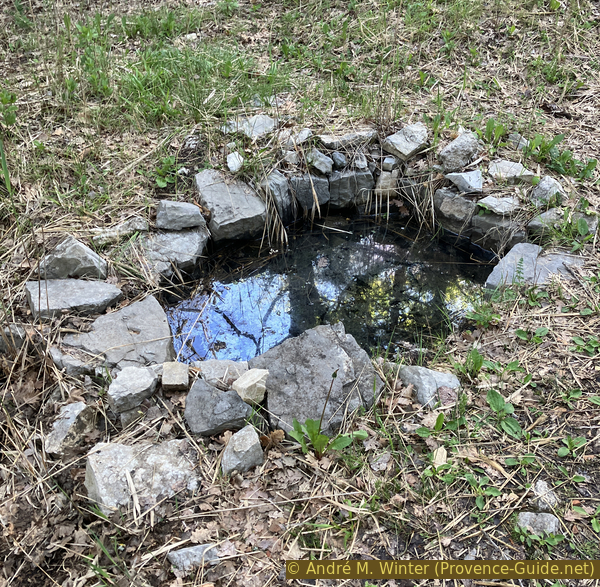
Resurgence of the Huguette sulfur spring
A little further on is the main source in a cavity covered by a vault and closed by a small wooden door.
The sulfur comes from gypsum deposits composed of hydrated calium sulfate CaSO4·2H2O which explains the source which leaches the sulfur.
This sulfur can be smelt a little, but we do not find the known yellow color which is only seen in its crystallized state. On the other hand, we see whitish filaments in the water of the spring and the dead plants that have fallen into the water are also bleached. These are sulfobacteria or thiobacteria which cause the oxidation of hydrogen sulfide H2S (toxic gas with the smell of rotten eggs), transforming them into sulfur S then into sulfates SO4.
The source is called Huguette, which was the name of the owners' daughter in 1933. However, it has been known for much longer and also had the names of Source de Renacas, Source de la Cabane or Source du Château.
There are other sulfurous springs between Céreste and Manosque, but only that of St. Martin had a sufficient flow rate of a few tens of liters per minute which allowed the installation of thermal baths between 1893 and 1939. However, this flow rate varies up to a point of drying up completely between 1967 and 1969. Today, the flow of water would no longer be enough to supply the thermal baths.
No reproduction is permitted without the written consent of the author. (id7321)
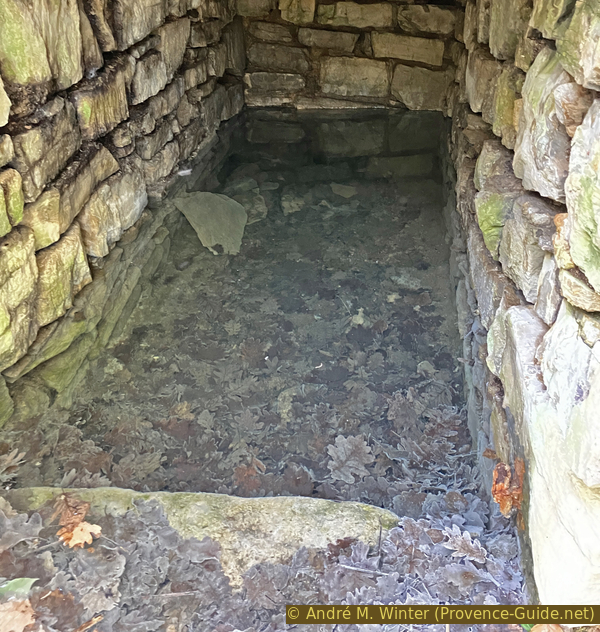
Sulfurous source Huguette in St. Martin les Eaux
So let's go down to the old thermal installations.
Arriving at the site, we find ourselves in front of corten steel panels. They give an impression of the small spa that was right there. Explanatory panels cover a large part. The geology and especially the history of the site are explained.
No reproduction is permitted without the written consent of the author. (id7322)
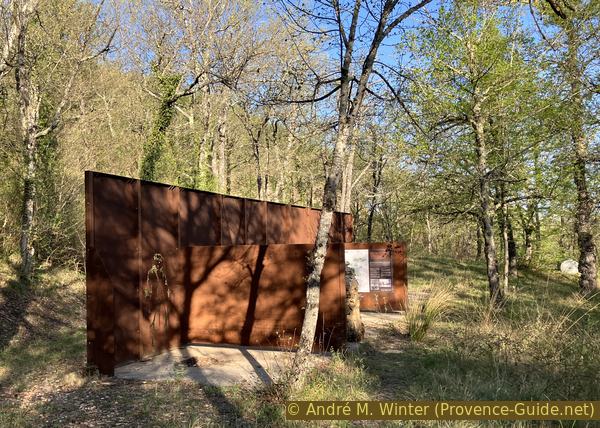
Reconstruction of the ancient thermal baths of St. Martin les Eaux
Thermal exploitation began in 1884, when the village was officially renamed from St. Martin-de-Renacas to St.-Martin-les-Eaux. At the beginning, the source remained free of access, spa guests only paid for hot baths and other services such as massages.
Initially, it was mainly rich farmers from the Cavaillon region who came. Rarely did Parisians pass by. In the 1930s, a less wealthy class also came to relax here.
In the 1930s, the source was renovated and it was this building which is reconstituted with rusty steel plates. At that time there was still a railway line between Apt and Volx with a stop at Lincel. They were brought by carts and later by bus to the Hôtel des Marronniers, which is now the municipal office of St. Martin.
The railway line was closed during the Second World War and spa guests no longer returned. The thermal baths were officially closed in 1942 and the buildings in the forest quickly fell into ruin. The thermal baths of Gréoux and Digne-les-Bains, with less strong waters, took over and are still active today.
No reproduction is permitted without the written consent of the author. (id7323)
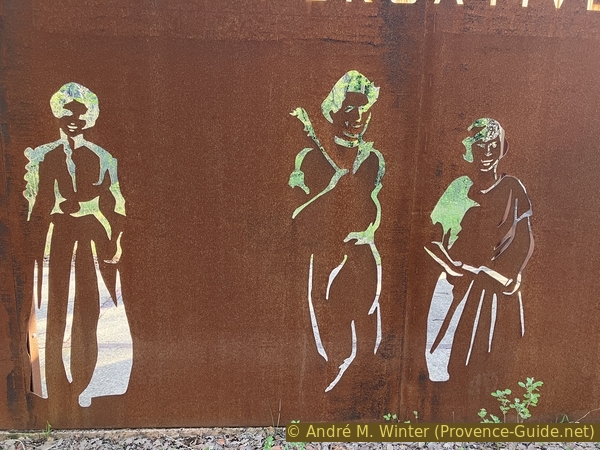
Figures of yesteryear on the reconstruction of the thermal baths
The spring water contains 450 milligrams of sulfate SO4 per liter. The legal limit in the European Union for drinking water is 250mg/liter. The water from the spring is therefore not good to drink, but it can be taken on medical indication for the same ailments as during thermal baths: skin diseases, intestinal diseases and rheumatism.
No reproduction is permitted without the written consent of the author. (id7332)
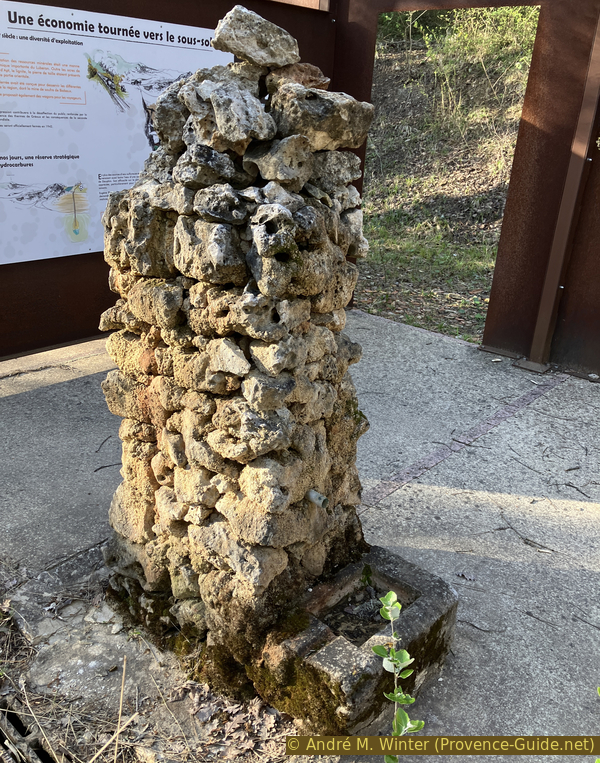
Ancient fountain in the reconstruction of the thermal baths
No reproduction is permitted without the written consent of the author. (id7315)
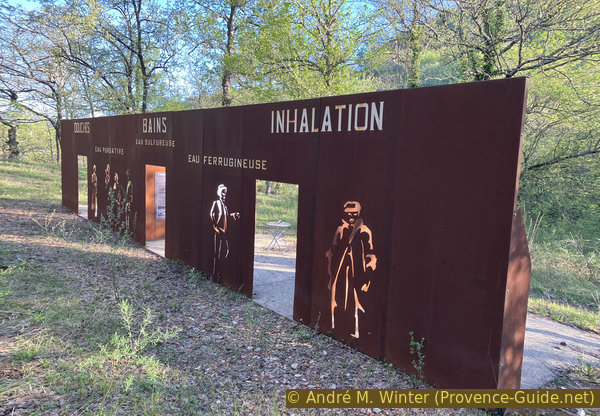
Reconstruction of the ancient thermal baths of St. Martin les Eaux